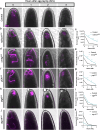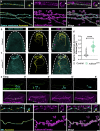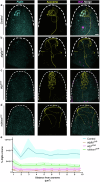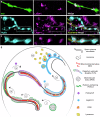Egg multivesicular bodies elicit an LC3-associated phagocytosis-like pathway to degrade paternal mitochondria after fertilization
- PMID: 38977659
- PMCID: PMC11231261
- DOI: 10.1038/s41467-024-50041-5
Egg multivesicular bodies elicit an LC3-associated phagocytosis-like pathway to degrade paternal mitochondria after fertilization
Abstract
Mitochondria are maternally inherited, but the mechanisms underlying paternal mitochondrial elimination after fertilization are far less clear. Using Drosophila, we show that special egg-derived multivesicular body vesicles promote paternal mitochondrial elimination by activating an LC3-associated phagocytosis-like pathway, a cellular defense pathway commonly employed against invading microbes. Upon fertilization, these egg-derived vesicles form extended vesicular sheaths around the sperm flagellum, promoting degradation of the sperm mitochondrial derivative and plasma membrane. LC3-associated phagocytosis cascade of events, including recruitment of a Rubicon-based class III PI(3)K complex to the flagellum vesicular sheaths, its activation, and consequent recruitment of Atg8/LC3, are all required for paternal mitochondrial elimination. Finally, lysosomes fuse with strings of large vesicles derived from the flagellum vesicular sheaths and contain degrading fragments of the paternal mitochondrial derivative. Given reports showing that in some mammals, the paternal mitochondria are also decorated with Atg8/LC3 and surrounded by multivesicular bodies upon fertilization, our findings suggest that a similar pathway also mediates paternal mitochondrial elimination in other flagellated sperm-producing organisms.
© 2024. The Author(s).
Conflict of interest statement
The authors declare no competing interests.
Figures








References
-
- Lillie FB. The mechanism of fertilization. Science (1979) 1913;38:524–528. - PubMed
-
- Fuller, M. T. The Development of Drosophila melanogaster (eds. Bate, M. & Martinez-Arias, A.) 71 (Cold Spring Harbor Laboratory Press, 1993).
MeSH terms
Substances
Grants and funding
- 616088/EC | EC Seventh Framework Programm | FP7 Ideas: European Research Council (FP7-IDEAS-ERC - Specific Programme: "Ideas" Implementing the Seventh Framework Programme of the European Community for Research, Technological Development and Demonstration Activities (2007 to 2013))
- 1279/19/Israel Science Foundation (ISF)
LinkOut - more resources
Full Text Sources
Molecular Biology Databases
Research Materials
Miscellaneous

